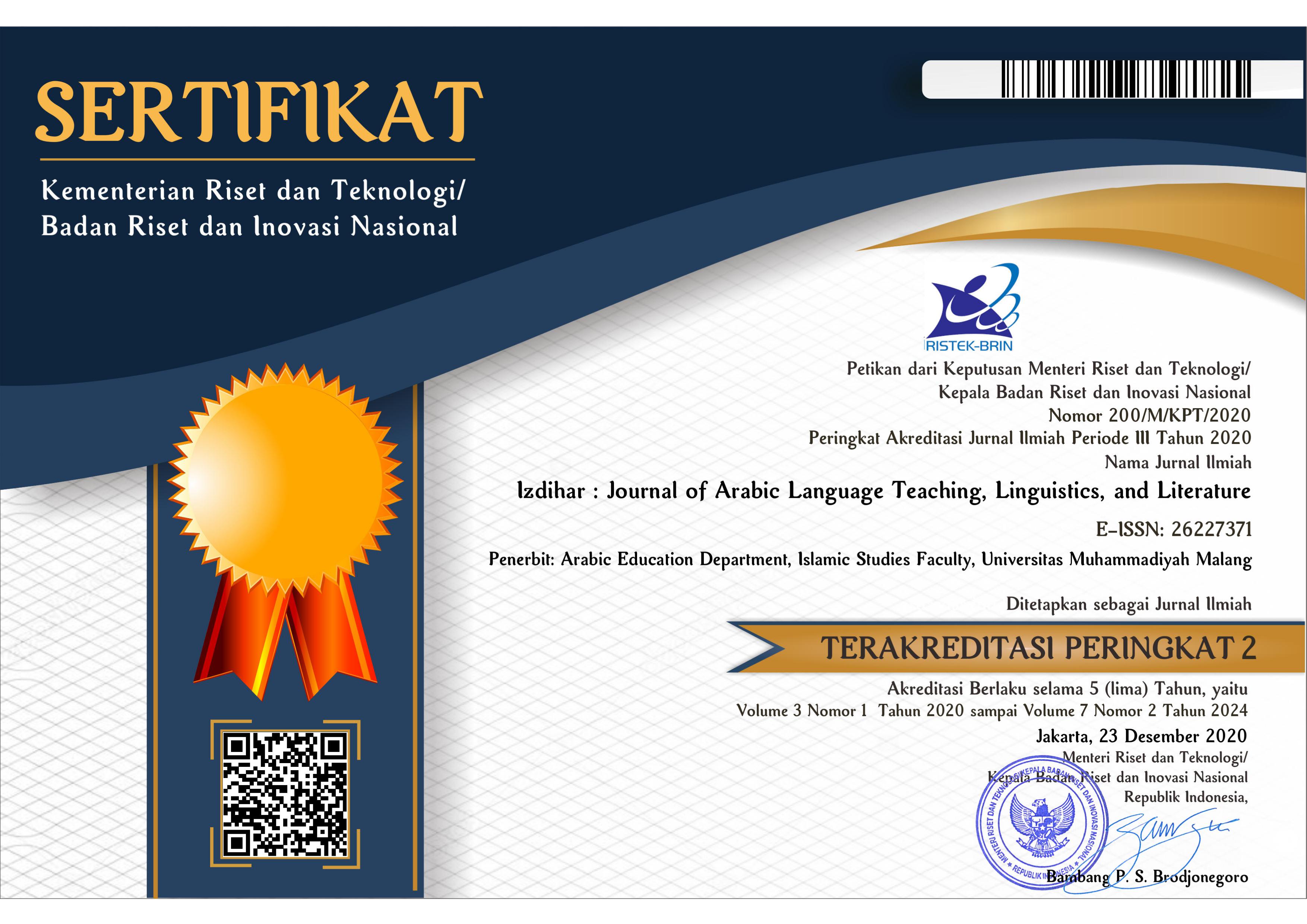Problems in Expressing Arabic Language of Indonesian Students at Khartoum International Institute for Arabic Language
DOI:
https://doi.org/10.22219/jiz.v2i1.7588Keywords:
Khartoum International Institute of Arabic Language, Student of Indonesia, Ta’bir ProblemsAbstract
This study was started with disclosure of issues faced by Indonesian students in Khartoum International Institute of Arabic Language. The main objective of this research revealed the ta’bir problem afflicting Indonesian students in learning classical Arabic, identifying the causes and knowing the impact of these problems in educational situations. To achieve the objective of this study, the method used by the researcher is descriptive analytical method. The results of this research are: 1) The ways which Indonesian students learned Arabic language in their institution have become instruments in improving Arabic language, 2) The impacts of the Indonesian dialects made difficulties for students in forming the Arabic dialect, 3) Environment in which treated the students outside the University affecting their ability in speaking classical Arabic, and 4) Weakness in disclosure affected students’ academic achievement. Then the researcher suggested solutions to solve those problems such as: 1) To help the students to develop their process in traditional Arabic, it is needed to the students to take the benefits from any means, as teacher teaches them by reading newspaper, magazine and scientific journal which gave them increase the outcome of their linguistics ability, 2) The commitment from the lectures of all subjects to speak in well-structured Arabic and avoid using slank is needed.
Downloads
References
Al-Amin, N. S., & Erwin Syaputra. (2016). Kemampuan Pengurus Rayon dalam Ta’bir Tahriri di Pondok Modern Darussalam Gontor. At-Ta’dib, 11(2).
Masqon, D., Yoke Suryadarma, & Achmad Farouq Abdullah. (2017). Analisis Problematika Pembelajaran Insya’ Insya’ Tahriri Santri Kelas V (KMI) di Pondok Modern Gontor Dua. At-Ta’dib, 12(2).
إسماعيل, ز. (2007). طرائق تدريس اللغة العربية أبو الضبعات. ______: دار الفكر.
التكينة, إ. (2011). مدخل إلى كتابة الفقرة. ______: مطبعة جامعة النيلين.
الدليمى, ط. ع. ح., & د. سعاد عبد الكريم الوائلى. (2009). اتجاهات حديثة فى تدريس اللغة العربية. ______: عالم الكتب الحديث.
الطاهر, م. ح. (2011). تعليم اللغة العربية لغير الناطقين بها. ______: الدار العالمية.
بوطري, أ. (2017). تطوير استراتيجية تعليم مهارة الكلام من خلال مدخل NLP. مجلة لسانيات, 8(1).
عصر, ح. ع. ا. (2005). No Title. ______: مركز الاسكندرية للكتاب.
عمر الصديق. (2008). تعليم اللغة العربية للناطقين بغيرها. ______: الدار العالمية.
محمد, ص. م. إ. (2007). مهارات التفكير و تعلم اللغة العربية و تعليمها. _______: مؤسسة حورس الدولية.
ياني, إ. (2017). المدخل الاتصالي في تعليم اللغة العربية لغير الناطقين بها. Lisanuna, 7(2).
Downloads
Published
How to Cite
Issue
Section
License
Copyright Notice
Authors who publish with this journal agree to the following terms:
- Authors retain copyright and grant the journal right of first publication with the work simultaneously licensed under a Creative Commons Attribution-ShareAlike 4.0 International License that allows others to share the work with an acknowledgment of the work's authorship and initial publication in this journal.
- Authors are able to enter into separate, additional contractual arrangements for the non-exclusive distribution of the journal's published version of the work (e.g., post it to an institutional repository or publish it in a book), with an acknowledgment of its initial publication in this journal.
- Authors are permitted and encouraged to post their work online (e.g., in institutional repositories or on their website) prior to and during the submission process, as it can lead to productive exchanges, as well as earlier and greater citation of published work (See The Effect of Open Access).
Copyright (c) 2019 Izdihar : Journal of Arabic Language Teaching, Linguistics, and Literature

This work is licensed under a Creative Commons Attribution-ShareAlike 4.0 International License.

















